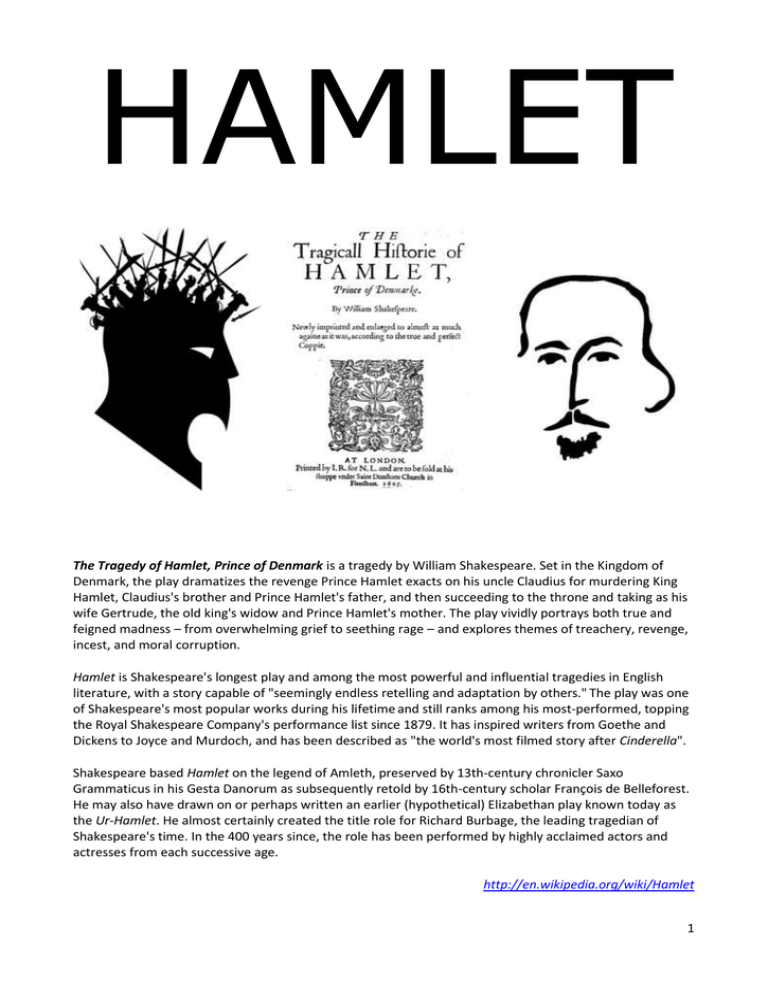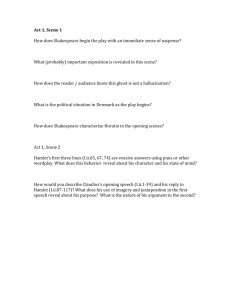From: Hamlet
advertisement

HAMLET The Tragedy of Hamlet, Prince of Denmark is a tragedy by William Shakespeare. Set in the Kingdom of Denmark, the play dramatizes the revenge Prince Hamlet exacts on his uncle Claudius for murdering King Hamlet, Claudius's brother and Prince Hamlet's father, and then succeeding to the throne and taking as his wife Gertrude, the old king's widow and Prince Hamlet's mother. The play vividly portrays both true and feigned madness – from overwhelming grief to seething rage – and explores themes of treachery, revenge, incest, and moral corruption. Hamlet is Shakespeare's longest play and among the most powerful and influential tragedies in English literature, with a story capable of "seemingly endless retelling and adaptation by others." The play was one of Shakespeare's most popular works during his lifetime and still ranks among his most-performed, topping the Royal Shakespeare Company's performance list since 1879. It has inspired writers from Goethe and Dickens to Joyce and Murdoch, and has been described as "the world's most filmed story after Cinderella". Shakespeare based Hamlet on the legend of Amleth, preserved by 13th-century chronicler Saxo Grammaticus in his Gesta Danorum as subsequently retold by 16th-century scholar François de Belleforest. He may also have drawn on or perhaps written an earlier (hypothetical) Elizabethan play known today as the Ur-Hamlet. He almost certainly created the title role for Richard Burbage, the leading tragedian of Shakespeare's time. In the 400 years since, the role has been performed by highly acclaimed actors and actresses from each successive age. http://en.wikipedia.org/wiki/Hamlet 1 2 3 “Shakespeare in Love” The theatres 1. Where were the theatres located at that time in London? Why? 2. Did you see any examples of control of the theatres? 3. Why was it not possible to have women actors? 4. Describe the architecture of the theatres. 5. Describe the scene – look at the drawing on the right. The drawing was created in 1596 by Johannes de Witt, a Dutch traveler who made the sketch while on a trip to London, shortly after the Swan playhouse was built. 4 Summary Scene 1 Denmark is in a state of alert fearing a Norwegian invasion. A Ghost closely resembling the late King appears. Scene 2 Claudius, the new King of Denmark, has married his brother’s widow Gertrude. He addresses the court, but his nephew, the dead King’s son Prince Hamlet, responds with bitterness. In a soliloquy, Hamlet expresses his disgust. Hearing of the ghost, he decides to speak to it. Scene 3 Hamlet has declared his affection for Ophelia. Her brother, Laertes, and her father, Polonius, instruct her to reject Hamlet’s love. She promises to do so. Scene 4 The Ghost appears and signals to Hamlet to follow him. Scene 5 Alone with Hamlet, the Ghost tells him that he is the spirit of Hamlet’s father who was poisoned by Claudius. The Ghost commands Hamlet to avenge his death. Hamlet decides to play mad and vows his friends, Horatio and Marcellus, to secrecy. Scene 1 Ophelia tells her father about a strange visit she has had from Hamlet. Polonius decides to tell the King. Scene 2 Claudius determines to spy on Hamlet. A company of actors arrives, and Hamlet makes a plan to test the truth of the Ghost’s story. Scene 1 The King and Polonius eavesdrop on the conversation between Hamlet and Ophelia. The King is convinced that his nephew is dangerous. Scene 2 The play-within-the-play is performed and breaks up in confusion. Scene 3 The King prays to God for forgiveness, not knowing that Hamlet, given the opportunity to kill him, spares his life. Scene 4 Hamlet kills Polonius accidentally. Rebuked by her son, Gertrude confesses her sins. The Ghost reappears. Hamlet hides Polonius’ body. Scene 1 Alone together the King and Queen tell each other lies. Scene 2 Rosencrantz and Guildenstern, the King’s hirelings, ask Hamlet where he has hidden Polonius’ body. Scene 3 Polonius’ body is discovered. Hamlet is sent to England where Claudius plans to have him executed. Scene 4 Hamlet meets the army of Fortinbras, Prince of Norway, on its way to fight in Poland. Hamlet reflects on the nature of honour. Scene 5 Ophelia goes mad and Laertes returns to avenge his father, Polonius. Scene 6 We learn that Hamlet has escaped back to Denmark. Scene 7 Claudius and Laertes plan Hamlet’s death. Scene 1 Two gravediggers discuss Ophelia’s suicide. Hamlet meditates on death and then fights Laertes by Ophelia’s grave. Scene 2 Hamlet is challenged to a fencing match with Laertes. Claudius poisons Hamlet’s wine, but Gertrude drinks it. Both Hamlet and Laertes are struck by a poisoned blade. Before they die, everything is sorted out and Hamlet forces Claudius to drink the poisoned wine. They die, and Fortinbras arrives and becomes King of Denmark. ACT I ACT II ACT III ACT IV ACT V 5 From: Hamlet – Cambridge School Edition , CUP, 1994 6 Hamlet’s soliloquies A soliloquy is a kind of internal debate spoken by a character who is alone on stage (or believes himself or herself to be alone). Soliloquies reveal the character’s true thoughts and feelings. Hamlet has 7 soliloquies: Act I, Scene 2: “O that this too too solid flesh would melt…” (pp. 74-75) Act I, Scene 5: “O all you host of heaven! O earth! what else?...” (pp. 92-93) Act II, Scene 2: “Now I am alone….” (pp. 120-121) Act III, Scene 1: “To be, or not to be, that is the question -…” (pp. 124-125) Act III, Scene 3: “’Tis now the very witching time of night,…” (p. 142) Act III, Scene 3: “Now might I do it pat, now a is a-praying,…” (pp. 144-145) ACT IV, Scene 4: “How all occasions do inform against me,…” (pp. 160-161) Questions for “O that this too too solid flesh would melt…” (pp. 74-75) 1. 2. 3. 4. 5. 6. 7. 8. 9. Put the soliloquy into context: what is the background for this speech? What does Hamlet want to do, and why is it impossible? (lines 129-132) What is it that he describes as “weary, stale, flat” etc.? (lines 133-137 What was his father like and how does he compare him to Claudius? (lines 138-140) What does he say about his parents’ love for each other? (lines 140-145) What are his feelings for his mother’s recent marriage to Claudius? (lines 146-157) What does he conclude and what does he decide? (lines 158-159) What does the audience learn from this soliloquy? What does this soliloquy add to the plot? Questions for “O all you host of heaven! O earth! what else?...” (pp. 92-93) 1. 2. 3. 4. Put the soliloquy into context: what is the background for this speech? What does Hamlet swear? What does the audience learn from this soliloquy? What does this soliloquy add to the plot? Questions for “Now I am alone….” (pp. 120-121) 1. 2. 3. 4. 5. 6. 7. Put the soliloquy into context: what is the background for this speech? What is he saying about the actor? (lines 457-563) And about himself? (lines 563-586) Comment on what he is saying about the ghost (line 582, lines 596-601). He gets an idea. What is it? (lines 586-603) What does the audience learn from this soliloquy? What does this soliloquy add to the plot? 7 Questions for “To be, or not to be, that is the question -…” (pp. 124-125) 1. 2. 3. 4. 5. 6. 7. 8. Put the soliloquy into context: what is the background for this speech? What is he thinking about (again) in lines 56 to 60? What is he looking forward to in lines 60 to 64? In lines 64 to 68 he is talking about a rub, an obstacle. What is the problem? What is it that makes people endure life? (lines 68-82) What is the problem with “conscience” and “thought”? (lines 83-88) What does the audience learn from this soliloquy? What does this soliloquy add to the plot? Questions for “’Tis now the very witching time of night,…” (p. 142) 1. Put the soliloquy into context: what is the background for this speech? 2. In Shakespeare’s time, revenge was a crime in law, and was also an irreligious act. For the Church of the late sixteenth century, revenge was considered a sin. The revenger’s soul was damned, condemned to suffer everlasting torment in hell. How do we see this in this soliloquy? 3. What does the reference to Nero (line 401) indicate? 4. What does the audience learn from this soliloquy? 5. What does this soliloquy add to the plot? Questions for “Now might I do it pat, now a is a-praying,…” (pp. 144-145) 1. 2. 3. 4. 5. 6. Why would it not be revenge to kill Claudius at this point? (lines 73-79) Why is it that Hamlet’s father did not go to heaven, but must be a ghost? (lines 80-84) What does he answer “no” to in line 87? What does Hamlet decide to do? (lines 88-96) What does the audience learn from this soliloquy? What does this soliloquy add to the plot? Questions for “How all occasions do inform against me,…” (pp. 160-161) 1. 2. 3. 4. 5. 6. 7. Put the soliloquy into context: what is the background for this speech? What is the meaning of the first two lines, and why the word “spur”? (lines 32-33) What is the difference between man and beast? (lines 33-43) What can he learn from Fortinbras (a delicate and tender prince)? (lines 43-56) How does Hamlet convince himself that he should not delay in his revenge? (lines 56-66) What does the audience learn from this soliloquy? What does this soliloquy add to the plot? AF/ 2012 8





